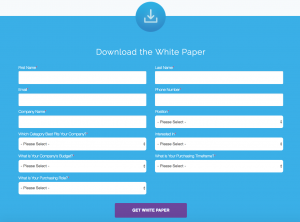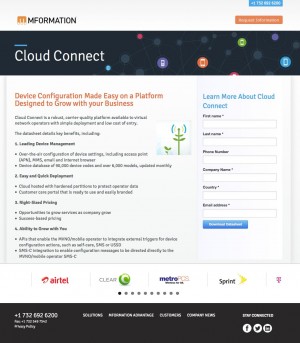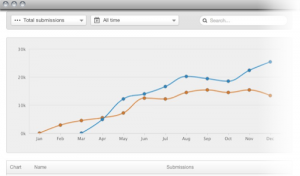
If you're like 68% of B2B businesses, you use landing pages to strategically get more leads (Marketo). But just having these pages isn't enough. Your landing page strategy is extremely important to the success of your website, to lead generation, and to business growth.
We hear many marketers and marketing teams make the same, common mistakes over and over. So learn these 6 myths about landing page strategy that can actually hurt your conversion rate.
 Asking many form questions can be OK if the value of the offer is strong. In this case, a well-researched white paper generates many leads for one B2B company.
Asking many form questions can be OK if the value of the offer is strong. In this case, a well-researched white paper generates many leads for one B2B company.
This statement may be true, but it is a bad, bad idea.
You could increase conversions dramatically if your landing page form asked one easy question — like, "What's your favorite color?" But you would also lower the bar for your leads coming in. So you might open up submissions to spammers, casual browsers, competitors, and others not really looking to partner with you in the long-term. (And this skews your metrics, muddles your lead database, and wastes your time.)
Also, fewer questions hurts you down the road. Because with less information on your new B2B contacts, you also lower the chance of creating relevant content and drip campaigns in the future.
Segmented campaigns increase click-throughs by 100%, according to MailChimp. But without lead intel, there is no segmentation.
So although we hear many marketers say a low-converting LP has too many questions, actually, it probably doesn't offer enough value. Provide more value with helpful, relevant, and rare content offers — don't ask fewer questions.
 This landing page contains plenty of text. But it's well-organized and compelling, so it helps, not hurts, conversion.
This landing page contains plenty of text. But it's well-organized and compelling, so it helps, not hurts, conversion.
When we quiz marketers on the success of a landing page design, we usually hear back: "That has too much text."
But, really, it's more about the quality of that text that matters, not length. If you need a long-scrolling page to get your point across well, go for it! Just make sure your text is organized, compelling, and relevant.
It should be easy to read — that's a simple truth of any good content. So chunk up your text with different headers, bold styles, icons, or data visualizations.
More text can actually help your landing page's SEO, too, since search engines have more content to crawl. And organic leads tend to be the highest converting, since they come with an intention or a question to answer:
SEO leads have a 14.6% close rate, while outbound leads (such as direct mail or print advertising) have a 1.7% close rate. – imFORZA
So don't jump automatically to reduce text on the page. Like before, increase the value of that text.
Not really. Just because you read somewhere that "orange call-to-action buttons increase conversion rates by 200%" doesn't mean that tactic will work for your business' landing page.
The only universal B2B "best practice" is that value, clarity, and quality will increase qualified conversions. (Click to Tweet!)
In other words, make sure that you have one offer on the page, and that the offer is relevant and helpful for your audience.
If you stick with "best practices" and never break the mold, soon, you will have landing pages that look and perform just like everybody else's. So if you want to succeed and stand out — and bring in an audience of leads that's right for you — challenge yourself to find your own best practices.
Design changes can help with conversions — especially in adding a trust-added tool like social proof:
Nearly 63% of consumers indicate they are more likely to purchase from a site if it has product ratings and reviews. – Search Engine Journal
But if there is no value in the offer or in the conversion, it won't matter how beautiful, interactive, or responsive your landing page is.
 Split tests
can be conclusive, but if you don't have tons of web traffic or time, they can also have misleading results that aren't absolute truths.
Split tests
can be conclusive, but if you don't have tons of web traffic or time, they can also have misleading results that aren't absolute truths.
Here again, not really. There was a recent webinar by Michael Aagaard of Unbounce about this topic, and he gave some wise thoughts. Imagine the front door of your brick-and-mortar store is locked. Nobody is coming in to shop. Would you really run an A/B test to see if a locked vs. unlocked door will increase sales? No way.
In other words, sometimes, conversion just comes down to common sense. Don't wait to have a statistically significant amount of visitors to come by (which can be several hundred or even several thousand, depending on the tested variables and desired outcome.) This will leave you waiting endlessly for insight, when you could really rely on common sense and intuition for many scenarios.
Split testing can show you some important things. For example, which call-to-action really, well, calls people to action. But draw the line between necessary data points and frivolous ones.
52% of companies and agencies that use landing pages also test them to find ways to improve conversions – Marketing Experiments
OK, conversion rate does matter. But not in the way that you might think. If I offered everyone who converts on my landing page $1,000, I will probably have a 100% conversion rate. But does that mean my business is growing? Probably not.
The moral here is that conversion rate doesn't matter so much as who you're converting and why. If you're converting 50% of visitors into blog subscribers, but 10% of visitors into sales qualified leads, the latter might actually be a better situation for growth, even though the actual "rate" is lower.
Since the quality of leads is relative to your business, your conversion rate goals should be relative, too. That's why we consider it harmful to use industry benchmarks as your common standard. For example, we've seen successful businesses convert anywhere between 2% to 90% of leads. So, the conversion rate doesn't matter as much as the quality of leads coming in.
If you read this article completely, you'll notice a common theme: Offering value with your landing pages.
Value doesn't need to be elusive or abstract. Really, it comes down to a few things: Relevancy, quality, and rarity. If you're just using a "Contact us" form, you're asking for something, not offering something of value. So dig into the actual needs of your visitors. Is your audience designers? Provide a free icon set that isn't available yet online. Are you trying to convert IT buyers? Create a comprehensive white paper with buying trends and statistics.
Do the research and the legwork up front to create relevant and value-added content, and your landing pages will improve.
https://www.ironpaper.com/articles/growth-hacking-strategies-for-b2b-tech-companies/
Sources
Marketing Experiments. https://www.marketingexperiments.com/blog/research-topics/landing-page-optimization-research-topics/registration-form-optimization-steps.html
MailChimp. https://mailchimp.com/resources/research/effects-of-list-segmentation-on-email-marketing-stats/
imFORZA. https://www.imforza.com/blog/8-seo-stats-that-are-hard-to-ignore/
by Jonathan Franchell, CEO of Ironpaper - For more tips and hacks: Need to remove a new line after h1 tags? Both web designers and SEO practitioners need to employ headline tags: H1, H2, H3 in several ways to improve web page structure and tag...

The Crowded Arena of the IT Marketplace Updated December 2024 The Information Technology (IT) landscape is experiencing rapid growth and intensifying competition. IT spending is projected to reach nearly 5.1 trillion U.S. dollars in 2024, a...

The marketing industry is transforming significantly due to generative AI and increasing market complexity. Gartner's prediction of a 25% decline in traditional search traffic suggests that the era of search engines is dying. AI tools, particularly...

Updated December, 2024 The field of digital marketing is evolving rapidly in response to new technology and changing buyer expectations. To help career-minded marketers, we’ve rounded up the top 10 skills needed to succeed in the field. These are...
